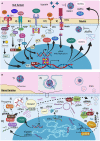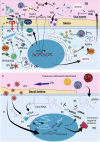A tangled threesome: understanding arbovirus infection in Aedes spp. and the effect of the mosquito microbiota
- PMID: 38235434
- PMCID: PMC10792067
- DOI: 10.3389/fmicb.2023.1287519
A tangled threesome: understanding arbovirus infection in Aedes spp. and the effect of the mosquito microbiota
Abstract
Arboviral infections transmitted by Aedes spp. mosquitoes are a major threat to human health, particularly in tropical regions but are expanding to temperate regions. The ability of Aedes aegypti and Aedes albopictus to transmit multiple arboviruses involves a complex relationship between mosquitoes and the virus, with recent discoveries shedding light on it. Furthermore, this relationship is not solely between mosquitoes and arboviruses, but also involves the mosquito microbiome. Here, we aimed to construct a comprehensive review of the latest information about the arbovirus infection process in A. aegypti and A. albopictus, the source of mosquito microbiota, and its interaction with the arbovirus infection process, in terms of its implications for vectorial competence. First, we summarized studies showing a new mechanism for arbovirus infection at the cellular level, recently described innate immunological pathways, and the mechanism of adaptive response in mosquitoes. Second, we addressed the general sources of the Aedes mosquito microbiota (bacteria, fungi, and viruses) during their life cycle, and the geographical reports of the most common microbiota in adults mosquitoes. How the microbiota interacts directly or indirectly with arbovirus transmission, thereby modifying vectorial competence. We highlight the complexity of this tripartite relationship, influenced by intrinsic and extrinsic conditions at different geographical scales, with many gaps to fill and promising directions for developing strategies to control arbovirus transmission and to gain a better understanding of vectorial competence. The interactions between mosquitoes, arboviruses and their associated microbiota are yet to be investigated in depth.
Keywords: Aedes aegypti; Aedes albopictus; RNA interference; Wolbachia; extracellular vesicles; insect specific virus; mosquito-borne disease; vectorial competence.
Copyright © 2024 Mantilla-Granados, Castellanos and Velandia-Romero.
Conflict of interest statement
The authors declare that the research was conducted in the absence of any commercial or financial relationships that could be construed as a potential conflict of interest.
Figures


Similar articles
-
Bidirectional Interactions between Arboviruses and the Bacterial and Viral Microbiota in Aedes aegypti and Culex quinquefasciatus.mBio. 2022 Oct 26;13(5):e0102122. doi: 10.1128/mbio.01021-22. Epub 2022 Sep 7. mBio. 2022. PMID: 36069449 Free PMC article.
-
Mosquito-Borne Viruses and Insect-Specific Viruses Revealed in Field-Collected Mosquitoes by a Monitoring Tool Adapted from a Microbial Detection Array.Appl Environ Microbiol. 2019 Sep 17;85(19):e01202-19. doi: 10.1128/AEM.01202-19. Print 2019 Oct 1. Appl Environ Microbiol. 2019. PMID: 31350319 Free PMC article.
-
Cell-Fusing Agent Virus Reduces Arbovirus Dissemination in Aedes aegypti Mosquitoes In Vivo.J Virol. 2019 Aug 28;93(18):e00705-19. doi: 10.1128/JVI.00705-19. Print 2019 Sep 15. J Virol. 2019. PMID: 31243123 Free PMC article.
-
Aedes aegypti and Ae. albopictus microbiome/virome: new strategies for controlling arboviral transmission?Parasit Vectors. 2022 Aug 9;15(1):287. doi: 10.1186/s13071-022-05401-9. Parasit Vectors. 2022. PMID: 35945559 Free PMC article. Review.
-
Deducing the Role of Virus Genome-Derived PIWI-Associated RNAs in the Mosquito-Arbovirus Arms Race.Front Genet. 2019 Nov 28;10:1114. doi: 10.3389/fgene.2019.01114. eCollection 2019. Front Genet. 2019. PMID: 31850054 Free PMC article. Review.
References
-
- Ahmad N. A., Mancini M. V., Ant T. H., Martinez J., Kamarul G. M. R., Nazni W. A., et al. . (2021). Wolbachia strain wAlbB maintains high density and dengue inhibition following introduction into a field population of Aedes aegypti. Philos. Trans. R. Soc. London. Ser. B, Biol. Sci. 376, 20190809. 10.1098/rstb.2019.0809 - DOI - PMC - PubMed
-
- Ajamma Y. U., Onchuru T. O., Ouso D. O., Omondi D., Masiga D. K., Villinger J. (2018). Vertical transmission of naturally occurring Bunyamwera and insect-specific flavivirus infections in mosquitoes from islands and mainland shores of Lakes Victoria and Baringo in Kenya. PLoS Negl. Trop. Dis. 12, e0006949. 10.1371/journal.pntd.0006949 - DOI - PMC - PubMed
-
- Alencar J., de Mello C. F., Marcondes C. B., Guimarães A. É., Toma H. K., Bastos A. Q., et al. . (2021). Natural infection and vertical transmission of Zika virus in sylvatic mosquitoes Aedes albopictus and Haemagogus leucocelaenus from Rio de Janeiro, Brazil. Trop. Med. Infect. Dis. 6, 99. 10.3390/TROPICALMED6020099 - DOI - PMC - PubMed
Publication types
Grants and funding
LinkOut - more resources
Full Text Sources
Miscellaneous

